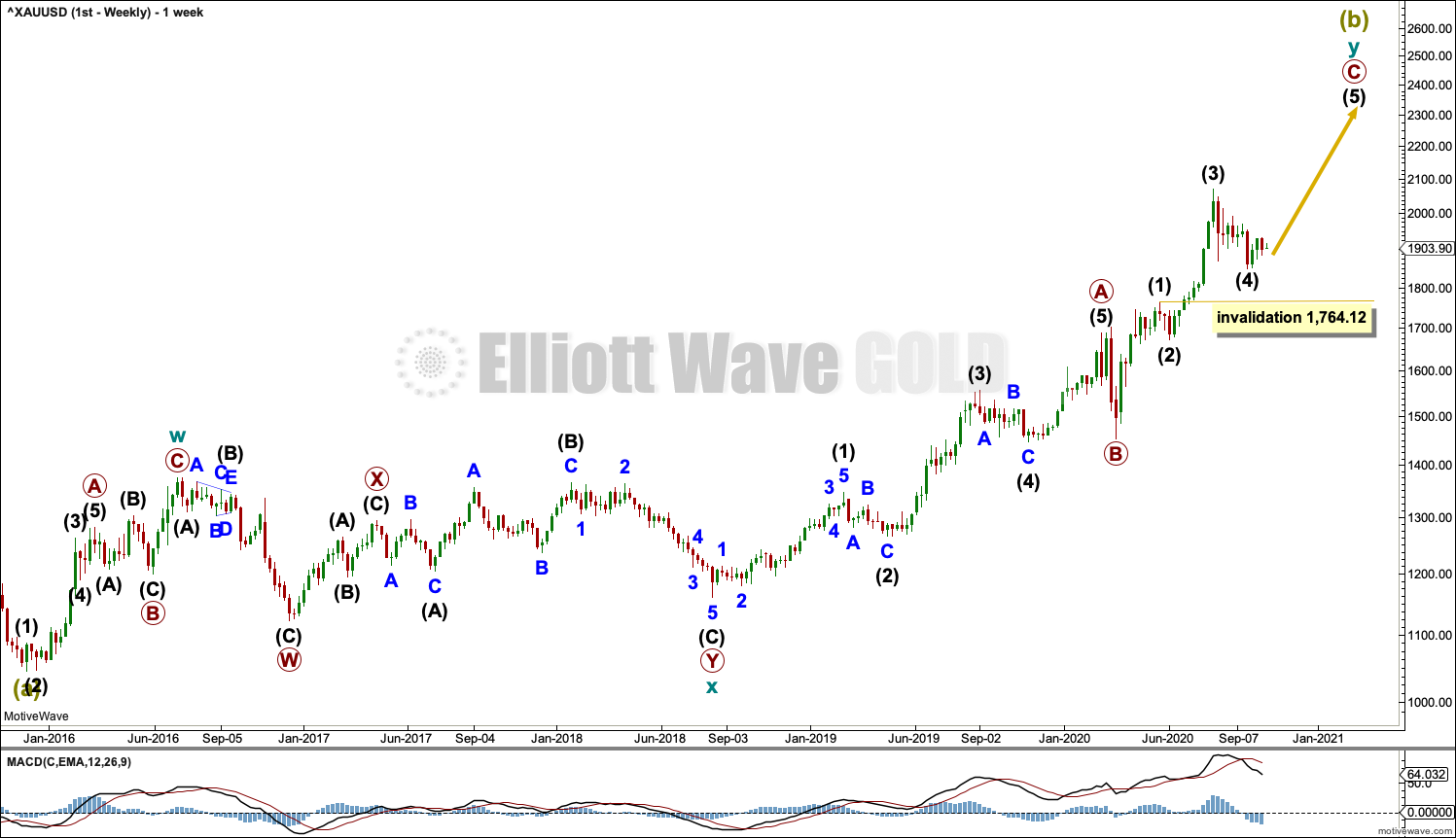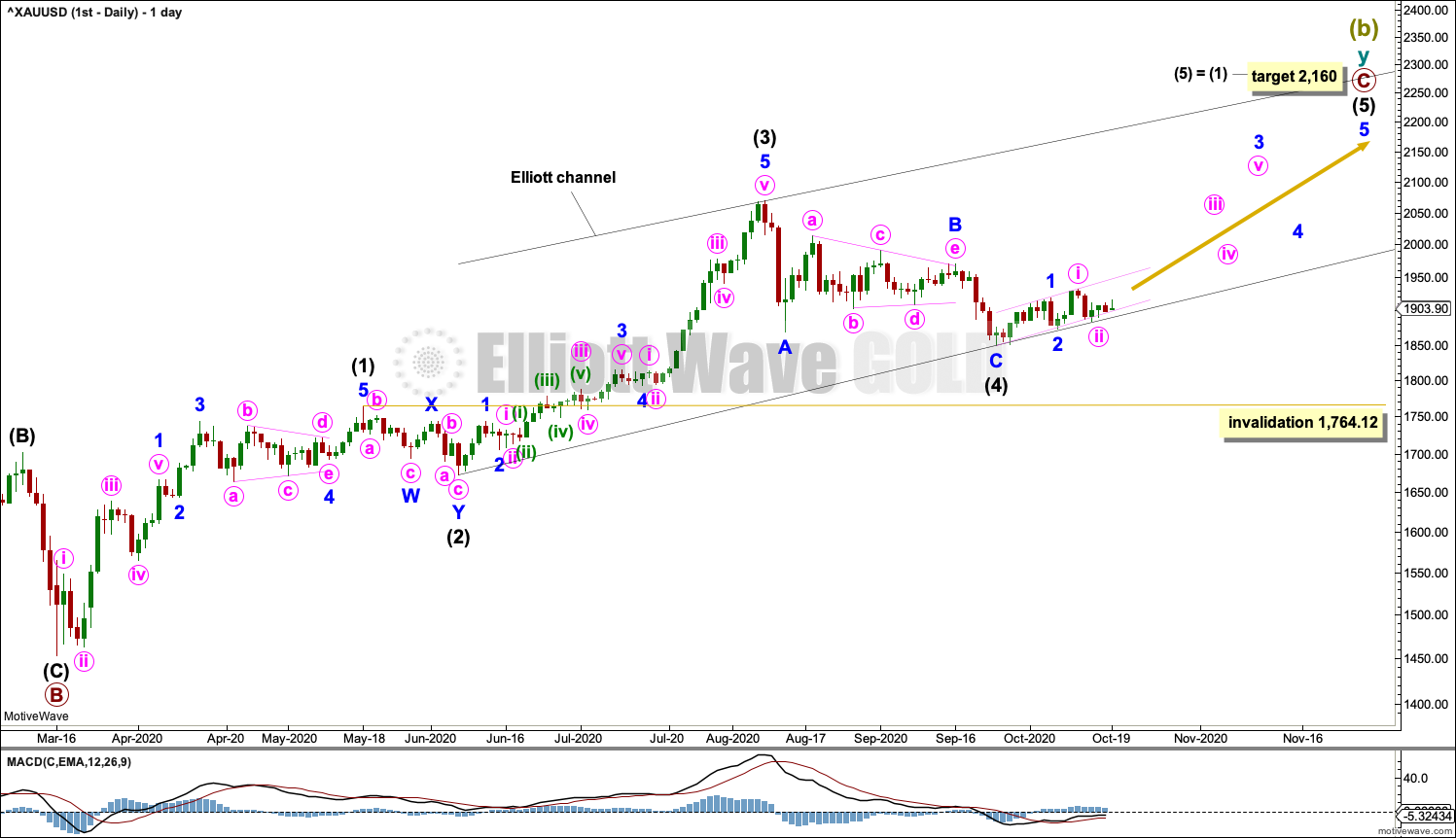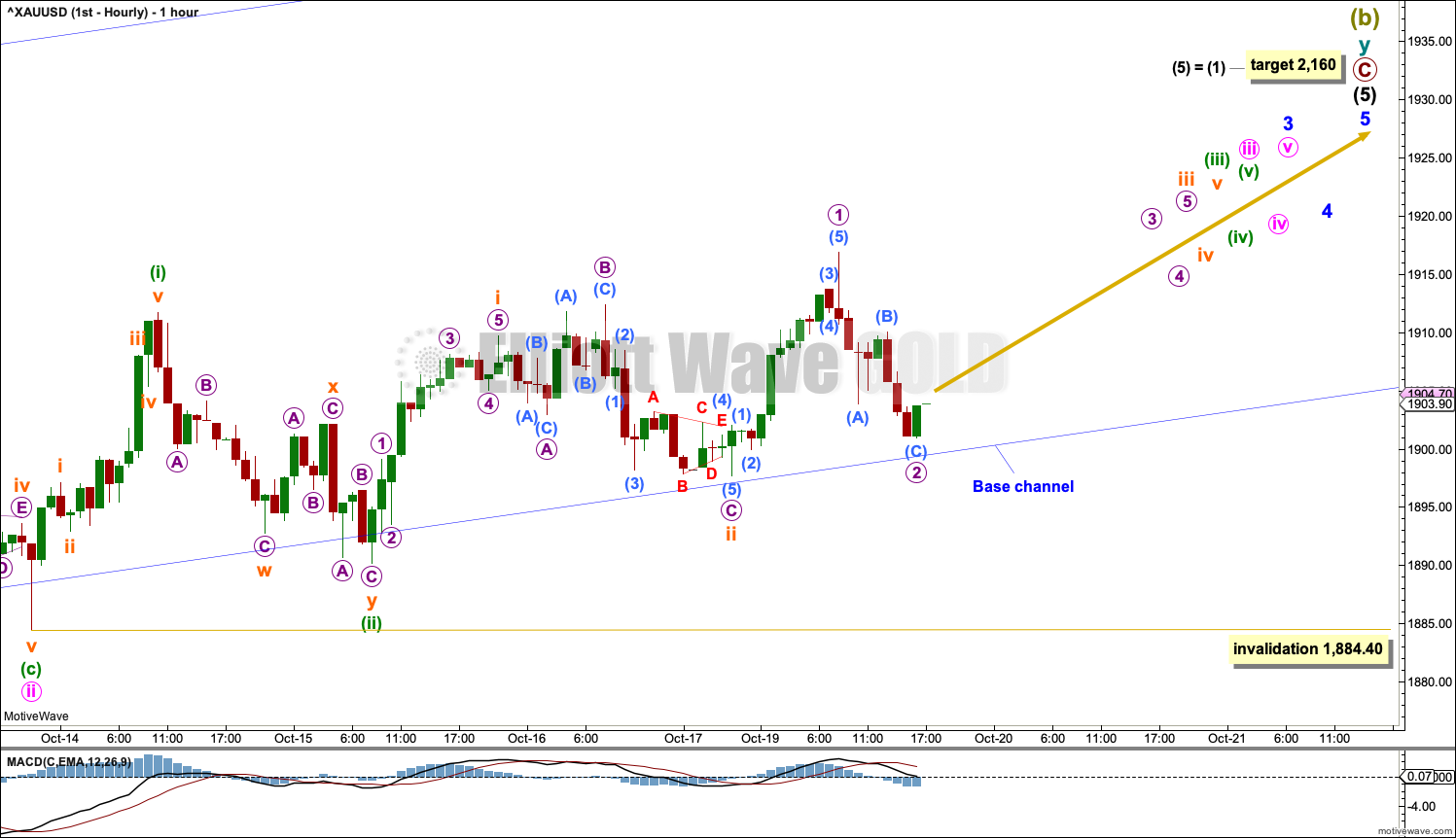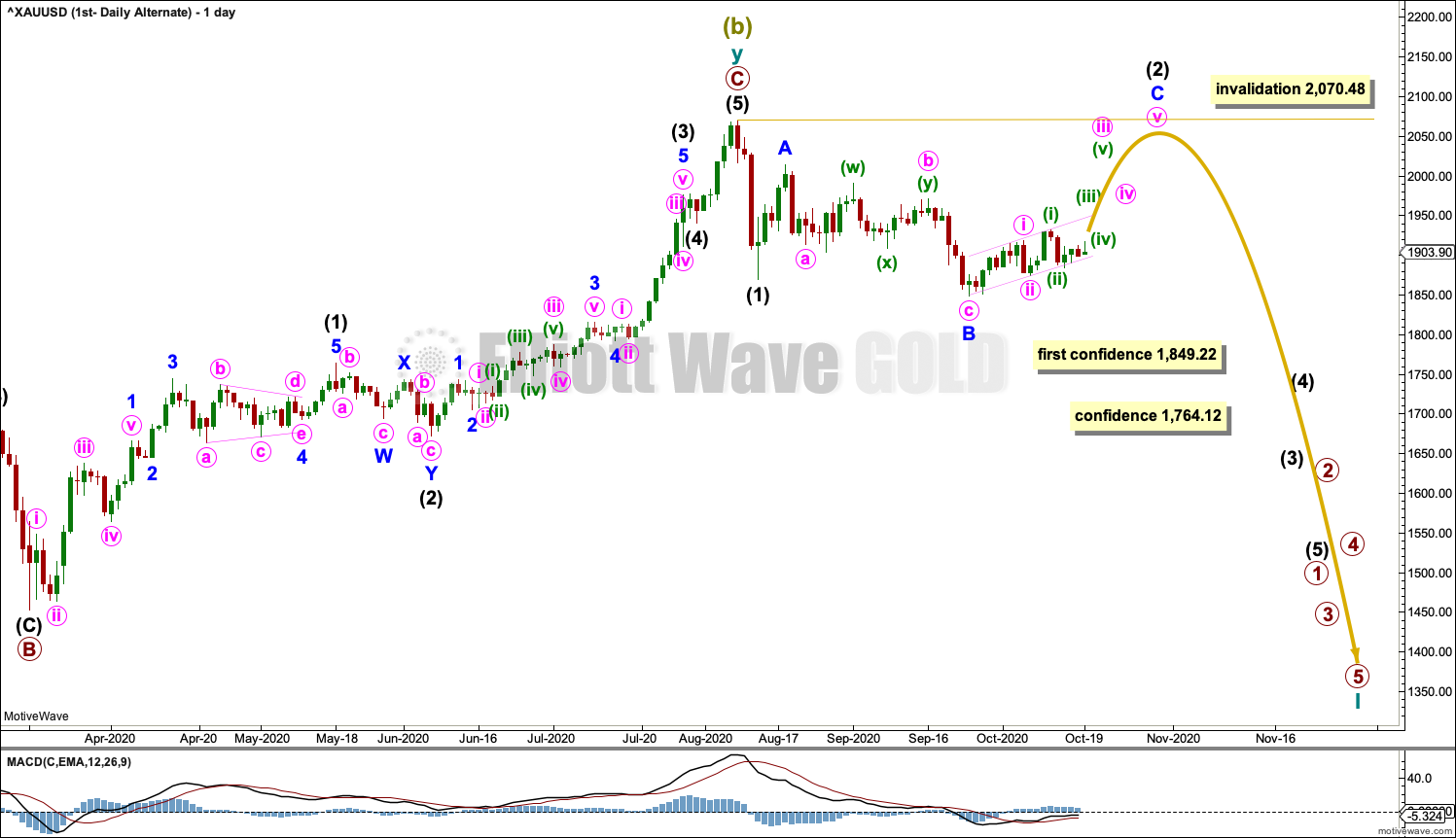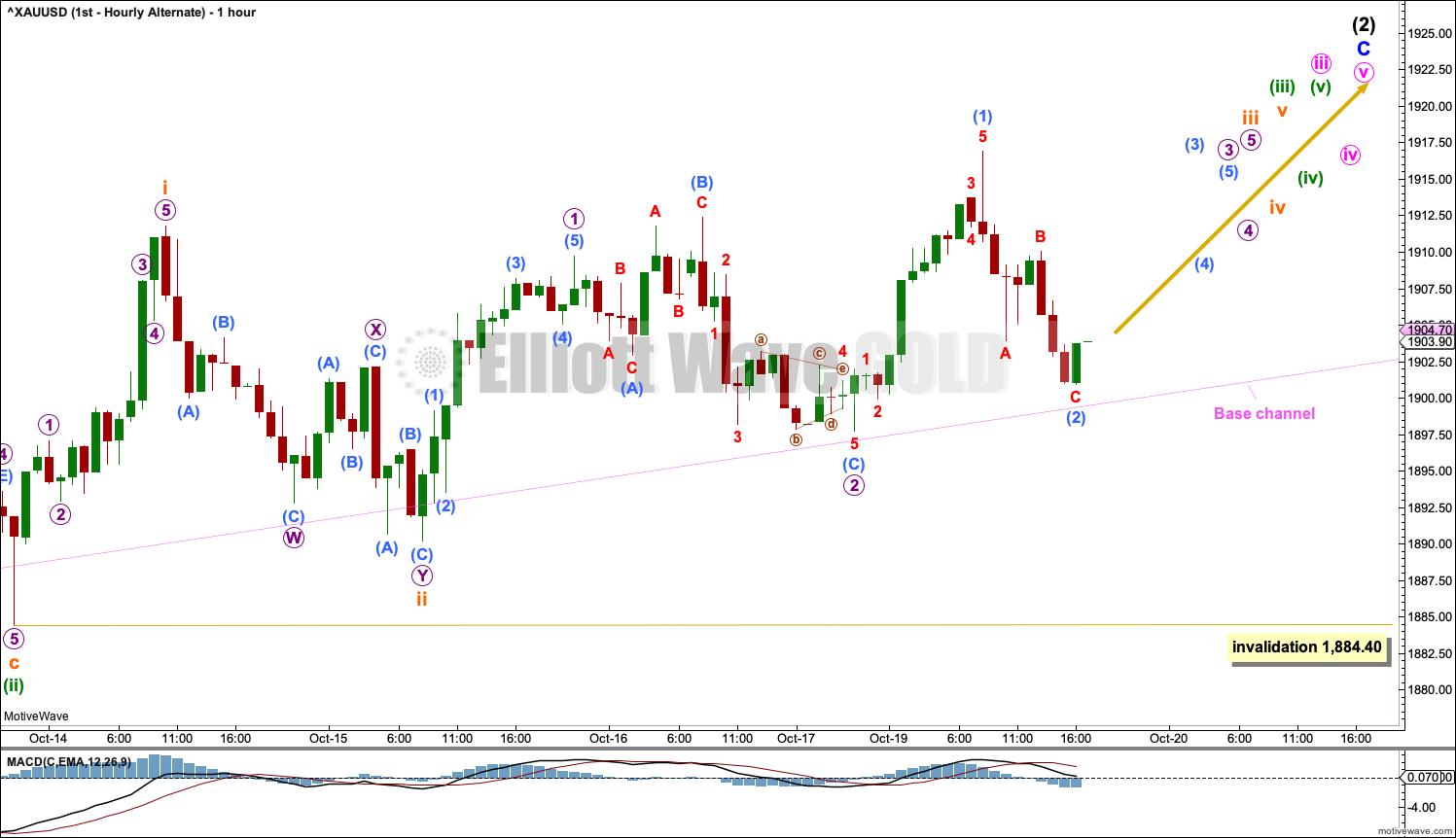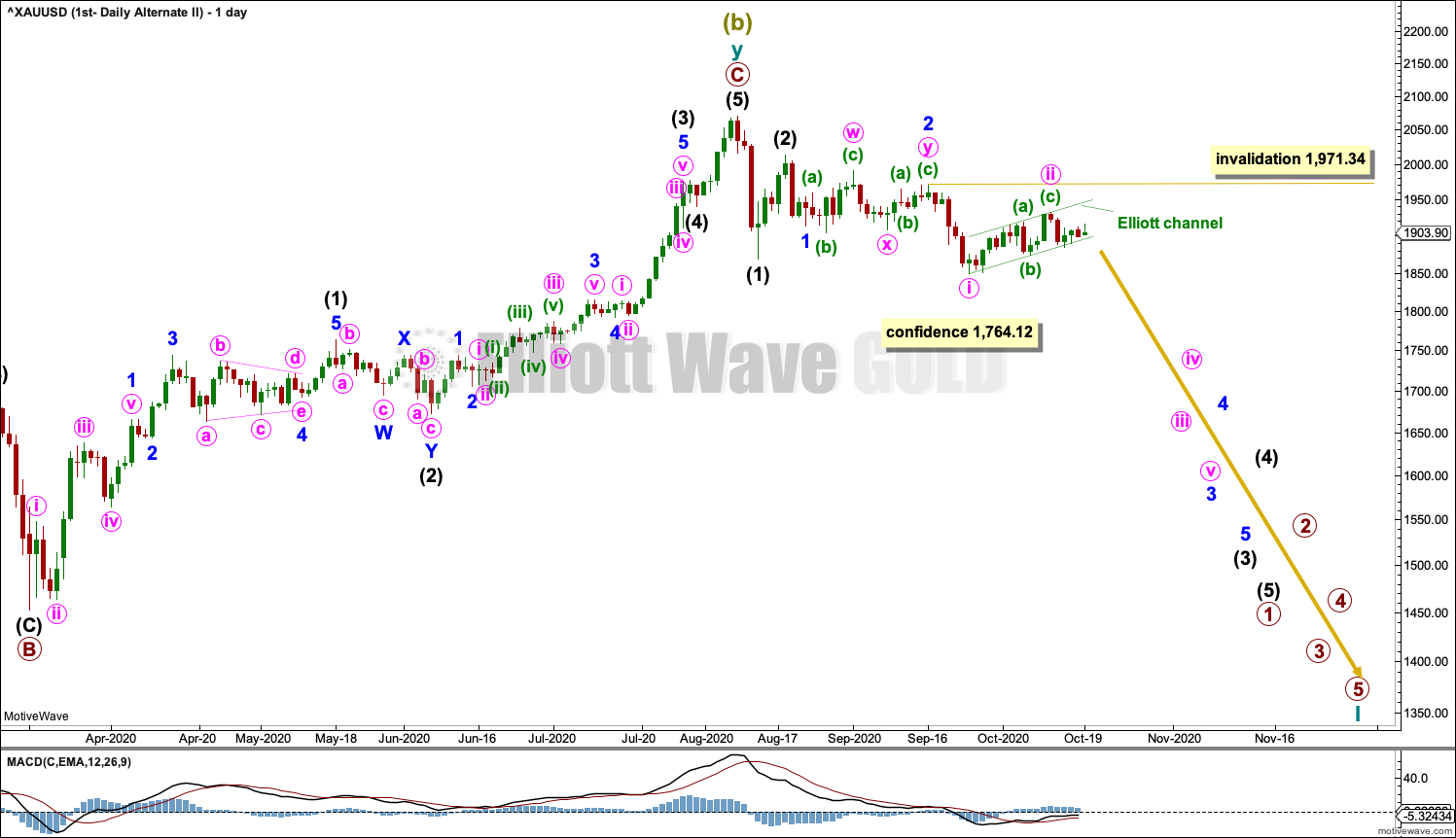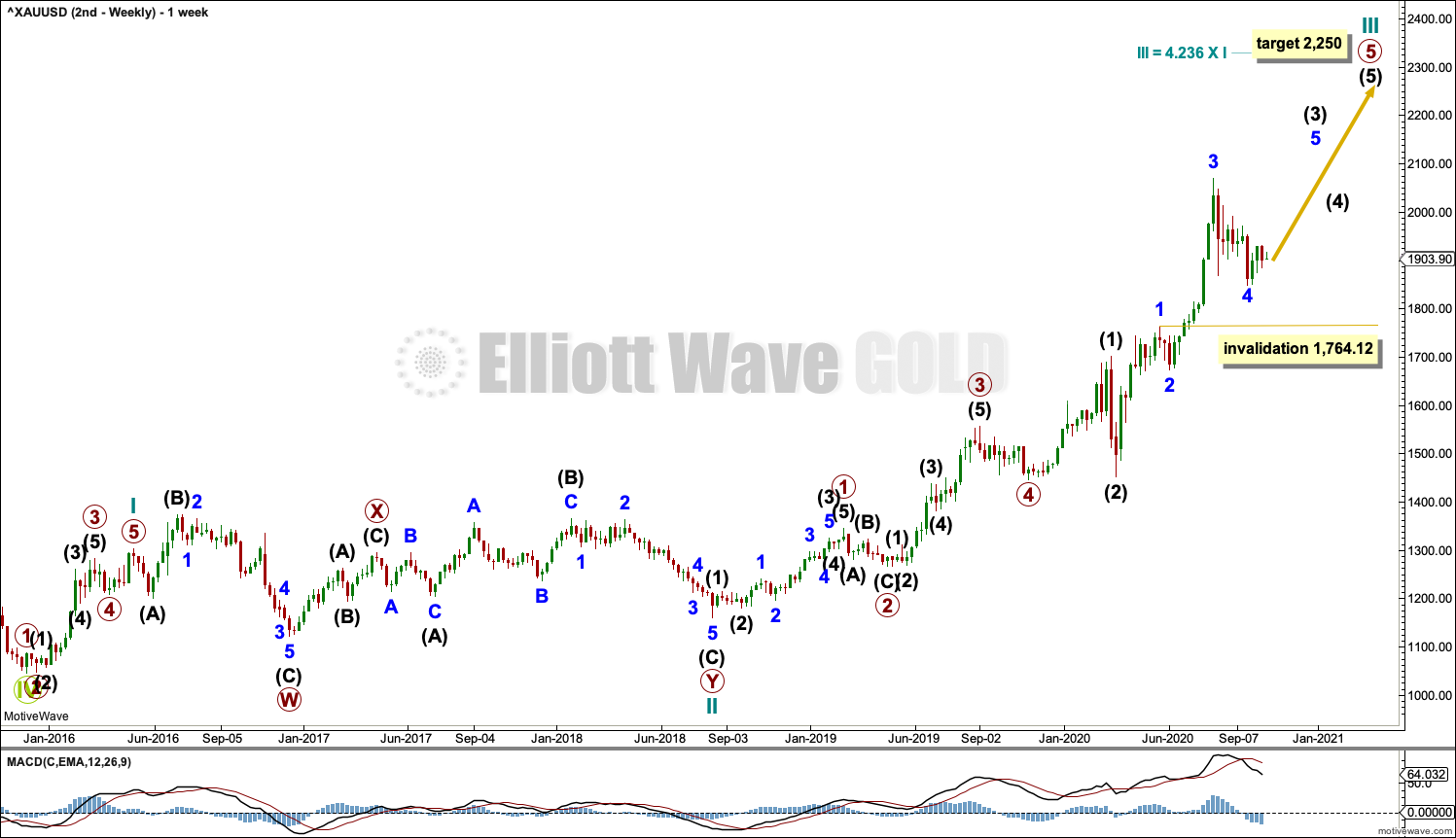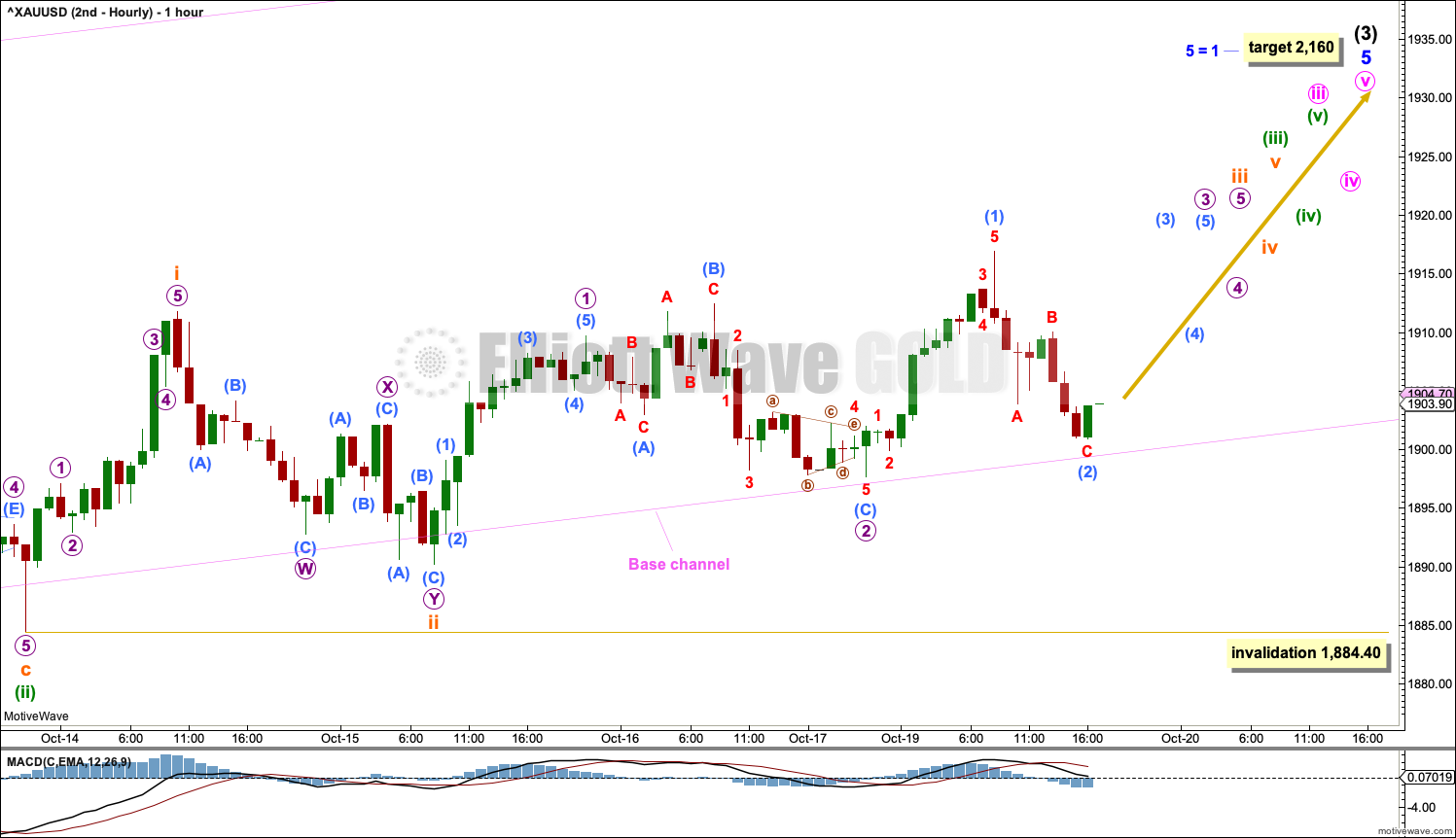GOLD: Elliott Wave and Technical Analysis | Charts – October 19, 2020
Price remains range bound within parallel trend lines.
All three Elliott wave counts remain the same.
Summary: The first and second Elliott wave counts expect upwards movement to 2,160.
A target calculated from the classic symmetrical triangle pattern for downwards movement is at 1,712. This aligns with the second alternate Elliott wave count.
The alternate Elliott wave count expects a bounce to end above 2,014.05 but not above 2,070.48 before the downwards trend begins to exhibit strength.
A second alternate wave count looks at the possibility of downwards movement here. Some confidence may be had in this idea with a new low below 1,849.22. A breach of the wide black channel on daily charts would increase the probability of this second alternate wave count.
A new low below 1,764.12 at any time frame would invalidate the first daily chart and add confidence in an alternate daily chart. At that stage, a sustainable high would be in place and a new downwards trend to last months may be underway.
Grand SuperCycle analysis is here.
Last analysis of monthly charts is here with video here.
FIRST ELLIOTT WAVE COUNT
WEEKLY CHART
The bigger picture for this first Elliott wave count sees Gold as still within a bear market, in a three steps back pattern that is labelled Grand Super Cycle wave IV on monthly charts. Grand Super Cycle wave IV may be subdividing as an expanded flat pattern. The common range for Super Cycle wave (b) within a flat is from 1 to 1.38 times the length of Super cycle wave (a), giving a range from 1,920.18 to 2,252.27. The target would see Super Cycle wave (b) end within this most common range.
Super Cycle wave (b) within Grand Super Cycle wave IV may be an incomplete double zigzag. When Super Cycle wave (b) may be complete, then this wave count expects Super Cycle wave (c) to begin and to move price below the end of Super Cycle wave (a) at 1,046.27.
The first zigzag in the double is labelled cycle wave w. The double is joined by a three in the opposite direction, a combination labelled cycle wave x. The second zigzag in the double is labelled cycle wave y.
The purpose of the second zigzag in a double is to deepen the correction. Cycle wave y has achieved this purpose.
Primary wave C within cycle wave y may be subdividing as an impulse. Intermediate waves (1) through to (4) within primary wave C may be complete. If it continues any lower, then intermediate wave (4) may not move into intermediate wave (1) price territory below 1,764.12.
We should always assume the trend remains the same until proven otherwise. At this stage, Gold is in a bull market.
DAILY CHART
The daily chart shows detail of primary wave C as an incomplete impulse.
Intermediate waves (1) through to (4) within primary wave C may be complete. Intermediate wave (4) may be a complete zigzag.
The channel is redrawn using Elliott’s second technique: the first trend line is drawn from the ends of intermediate waves (2) to (4), then a parallel copy is placed upon the end of intermediate wave (3). Intermediate wave (5) may end either mid way within the channel or about the upper edge. Corrections along the way up may find support about the lower edge. A breach of this channel would reduce the probability of this wave count.
If it continues lower, then intermediate wave (4) may not move into intermediate wave (1) price territory below 1,764.12.
A target is calculated for intermediate wave (5) that expects it to exhibit the most common Fibonacci ratio to intermediate wave (1).
HOURLY CHART
This hourly chart focusses on movement from the high labelled minute wave i, which can be seen on the daily chart.
Minor wave 3 may only subdivide as an impulse. Minute wave i within minor wave 3 may be complete at the last high, finding resistance at the upper edge of the blue base channel, which is copied over from the daily chart. Minute wave ii may now find support about the lower edge of the base channel with small overshoots. If this base channel is breached by downwards movement, then the probability of this wave count would reduce.
Minute wave iii within minor wave 3 should exhibit strength. Minute wave iii should have the power to break above resistance at the upper edge of the base channel.
Minuette wave (ii) within minute wave iii may not move beyond the start of minuette wave (i) below 1,884.40.
While Gold often finds support at the lower edge of base channels in bull markets, it does not always do so. Occasionally, it may breach base channels as it forms deep second wave corrections to then move higher in a third wave. For this reason the invalidation point is left at 1,884.40 until minute wave iii moves above the end of minute wave i at 1,932.16.
ALTERNATE DAILY CHART
It is also possible that a Super Cycle degree trend change has occurred at the last high. However, we should always assume the trend remains the same until proven otherwise. Assume the upwards trend remains in place and the main wave count is correct until the upwards trend is invalidated with a new low below 1,764.12. At that stage, this would become the main wave count.
Intermediate wave (2) may be an incomplete expanded flat correction. Minor wave B within intermediate wave (2) was a 1.14 length of minor wave A, which is within the most common range of 1 to 1.38 times the length of minor wave A.
Minor wave C within intermediate wave (2) would be likely to make a new high above the end of minor wave A at 2,014.05 to avoid a truncation. Intermediate wave (2) may not move beyond the start of intermediate wave (1) above 2,070.48.
Super Cycle wave (c) would be likely to make at least a slight new low below the end of Super Cycle wave (a) at 1,046.27 to avoid a truncation. If price provides confidence in this wave count with a new low below 1,764.12, then a target would be calculated for Super Cycle wave (c) to end.
ALTERNATE HOURLY CHART
Minor wave C must subdivide as a five wave motive structure, most likely an impulse.
Minute waves i and ii may be complete. Minute wave iii may have begun.
Minute wave iii may only subdivide as an impulse. Minuette waves (i) and (ii) within minute wave iii may now be complete. Minuette wave (i) may have found resistance at the upper edge of a base channel, which is drawn about minute waves i and ii and copied over from the daily chart. Minuette wave (ii) may find support about the lower edge of the base channel with small overshoots. If this base channel is breached by downwards movement, then the probability of this wave count would reduce.
Minuette wave (iii) within minute wave iii should have the power to break above resistance at the upper edge of the base channel.
Subminuette wave ii within minuette wave (iii) may not move beyond the start of subminuette wave i below 1,884.40.
SECOND ALTERNATE DAILY CHART
It is possible for this alternate wave count that a series of three first and second waves may be complete. A third wave down may begin to develop strength.
A breach of the green Elliott channel would increase the probability of this second alternate wave count.
Minute wave ii may not move beyond the start of minute wave i above 1,971.34.
A new low below 1,849.22 would add initial confidence to this wave count. A new low below 1,764.12 would add reasonable confidence.
SECOND ELLIOTT WAVE COUNT
WEEKLY CHART
This wave count sees the the bear market complete at the last major low for Gold on 3 December 2015.
If Gold is in a new bull market, then it should begin with a five wave structure upwards on the weekly chart.
Cycle wave I fits as a five wave impulse with reasonably proportionate corrections for primary waves 2 and 4.
Cycle wave II fits as a double flat. However, within the first flat correction labelled primary wave W, this wave count needs to ignore what looks like an obvious triangle from July to September 2016 (this can be seen labelled as a triangle on the first wave count above). This movement must be labelled as a series of overlapping first and second waves. Ignoring this triangle reduces the probability of this wave count in Elliott wave terms.
Cycle wave III may be incomplete. Minor wave 4 within primary wave 5 may not move into minor wave 1 price territory below 1,764.12.
DAILY CHART
Cycle wave III may be incomplete. The daily chart focusses on primary wave 5 within cycle wave III.
Minor wave 4 may be a complete zigzag. Minute wave b within the zigzag may be a complete triangle.
If minor wave 4 continues lower, then it may not move into minor wave 1 price territory below 1,764.12.
The channel about intermediate wave (3) is drawn using Elliott’s second technique.
HOURLY CHART
A target is calculated for minor wave 5 to end intermediate wave (3).
Minor wave 5 must subdivide as a five wave motive structure.
Minute waves i and ii within minor wave 5 may be complete.
Minute wave iii must subdivide as an impulse. Minuette waves (i) and (ii) within minute wave iii may be complete. Minuette wave (i) found resistance about the upper edge of a base channel copied over from the daily chart, and minuette wave (ii) may have found support about the lower edge with small overshoots.
Minuette wave (iii) of minute wave iii should have the power to break above resistance at the upper edge of the base channel.
Subminuette wave ii within minuette wave (iii) may not move beyond the start of subminuette wave i below 1,884.40.
TECHNICAL ANALYSIS
WEEKLY CHART
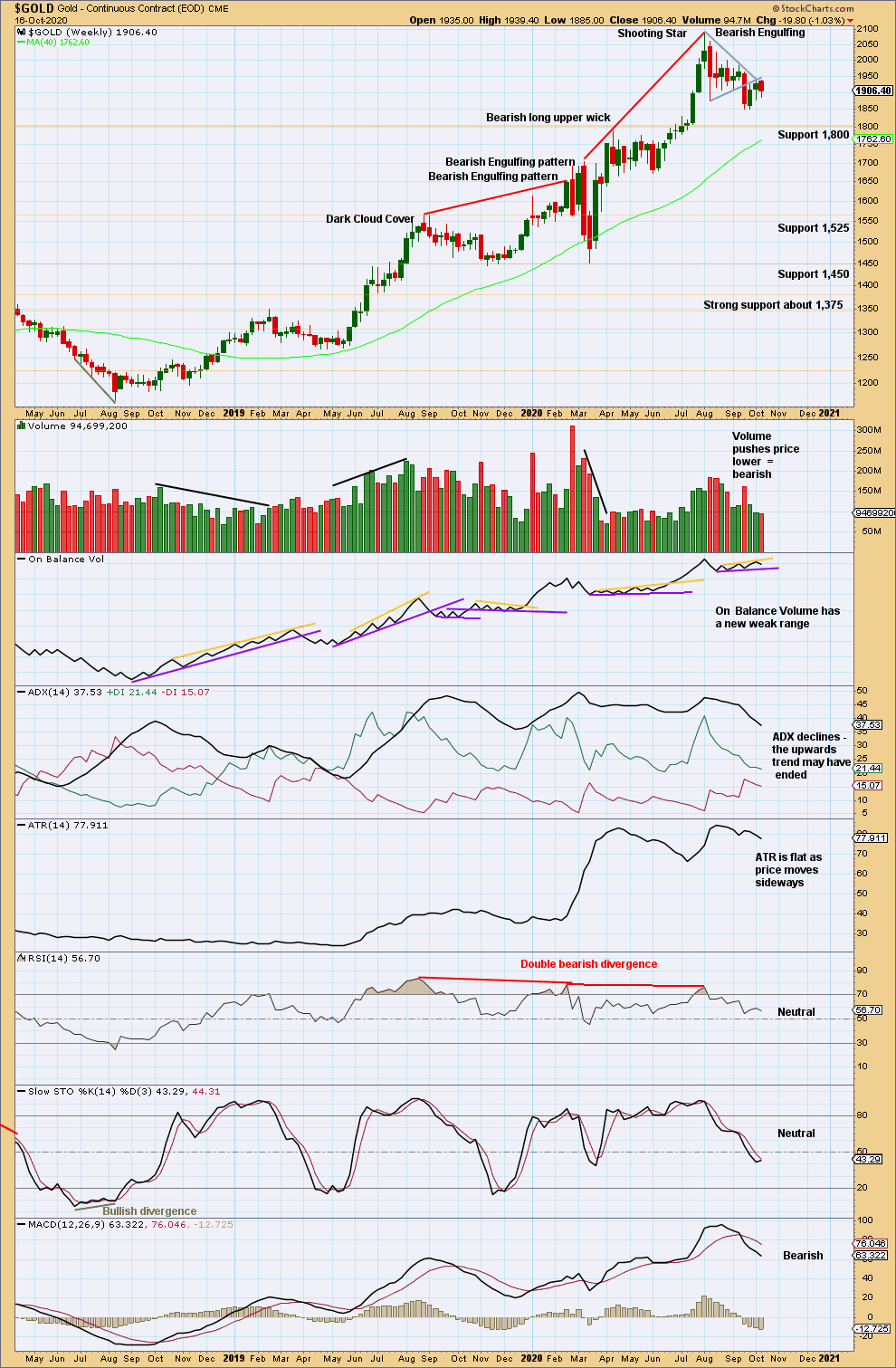
Click chart to enlarge. Chart courtesy of StockCharts.com.
Price has broken out downwards from a small triangle. Look for next support about 1,800.
At the last high were two bearish candlestick patterns with overbought RSI exhibiting double bearish divergence. It is possible there may have been a 180° trend change at the high. A new swing low below 1,671.70 would add confidence in that view.
Upwards movement again last week lacks support from volume, but that does not mean this may not be the first week of a multi-week rise to new all time highs. Early stages of trends for Gold do not always begin with strength; there are prior examples on this chart.
So far price is finding resistance about the lower edge of the small triangle trend line. On Balance Volume is at resistance. This week this view remains the same.
DAILY CHART

Click chart to enlarge. Chart courtesy of StockCharts.com.
A flag pattern may have formed. A target calculated from the flag pole would be about 1,754. A downwards breakout from the flag would be required before confidence in this target may be had. A downwards breakout does not require support from volume for confidence; but, when volume does confirm a downwards breakout, it is impressive.
The best performing flags and pennants complete within 15 or fewer sessions. So far this possible flag pattern has lasted 16 sessions. The usefulness of this possible flag has now declined as it has lasted beyond 15 sessions.
On Balance Volume is at strong resistance. This may halt a rise in price and force a downwards breakout from the flag.
GDX WEEKLY CHART
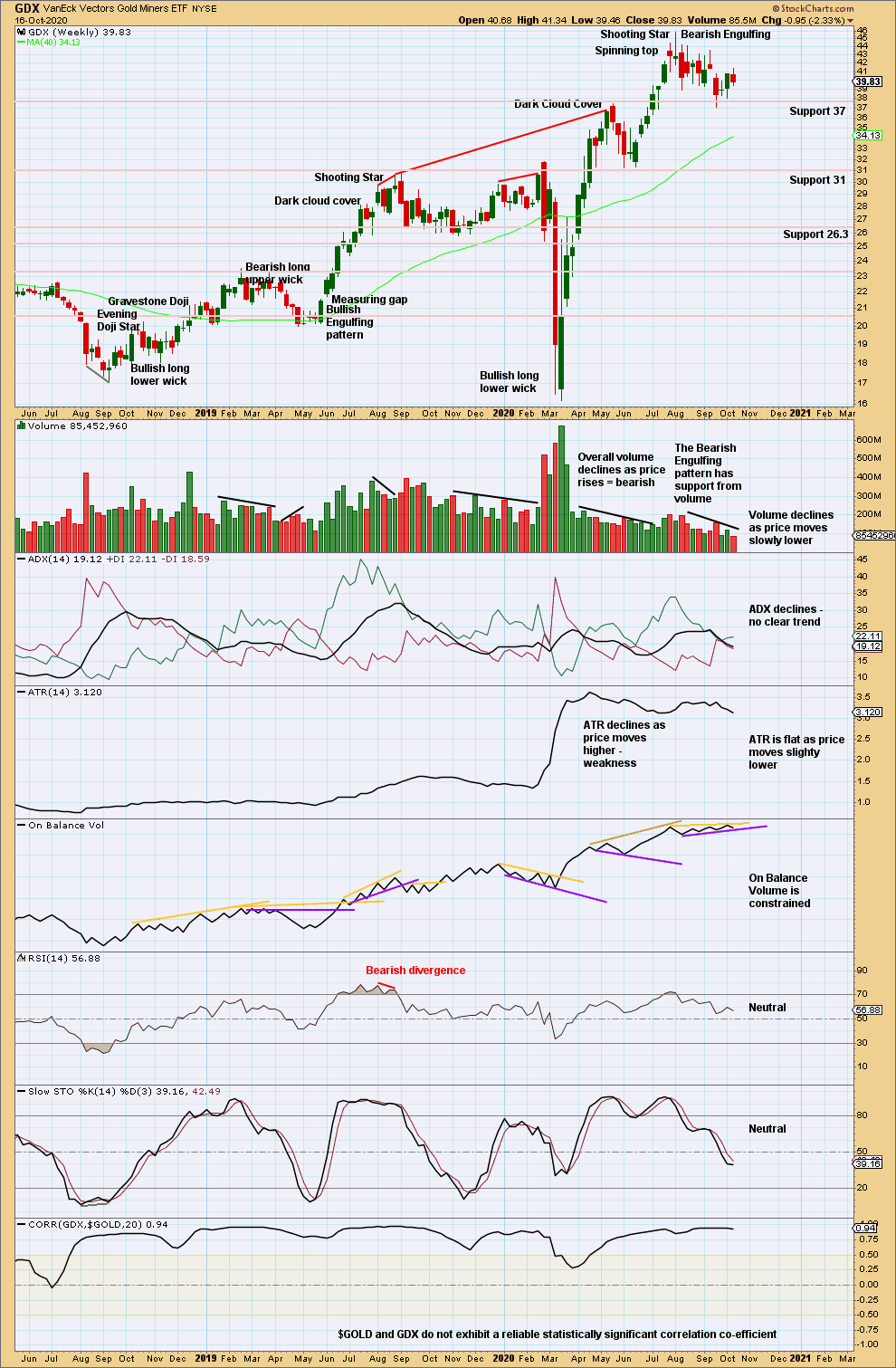
Click chart to enlarge. Chart courtesy of StockCharts.com.
Overall, the choppy nature of downwards movement looks like a pullback within an ongoing larger bull market for GDX. This pullback may move lower before it is complete. A new low below 31.22 of the 1st of June would indicate a trend change.
GDX DAILY CHART

Click chart to enlarge. Chart courtesy of StockCharts.com.
A flag pattern may be completing on GDX. The pattern may have lasted a total 17 sessions, so the reliability of it is reduced.
Today may have seen a downwards breakout with a very little support from volume. Price has closed only just below the lower trend line. In this instance, one more session with a lower close would add confidence in a downwards breakout.
A target from the flag would be about 32.73.
Published @ 06:37 p.m. ET.
—
Careful risk management protects your trading account(s).
Follow my two Golden Rules:
1. Always trade with stops.
2. Risk only 1-5% of equity on any one trade.
—
New updates to this analysis are in bold.

